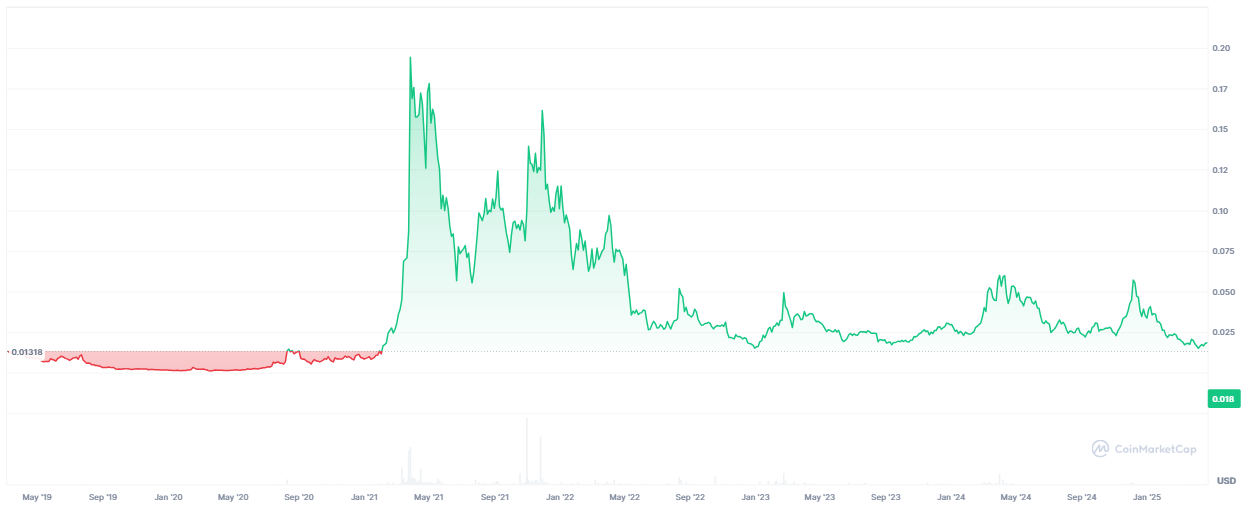Ankr Price Prediction: Will ANKR Take Off or Crash?
Ankr plays a behind-the-scenes but foundational role in Web3. It powers the infrastructure many decentralized apps rely on, offering fast RPC endpoints, staking integrations, blockchain scaling solutions, and custom rollups. Whether you’re using a DeFi app, minting on an L2, or staking ETH through a liquid wrapper, there’s a good chance Ankr is somewhere in the stack.
This article breaks down how the Ankr ecosystem works, how the ANKR token fits into it, and what that might mean for its value over time. We’ll look at the core services, token mechanics, growth strategy, and realistic price expectations for 2025 and 2030 based on network adoption and competitive pressures.
None of this is financial advice. Crypto markets are volatile, and while infrastructure tokens often reflect real usage, price trends can still swing independently of fundamentals.
What Is Ankr (ANKR)?
ANKR is the native token of the Ankr Network, used to facilitate operations across its suite of decentralized infrastructure products. It plays several roles: it’s a payment token for accessing premium services like RPC endpoints and API calls, a staking token for both liquid and delegated staking systems, and a utility asset within Ankr-powered rollups and validator nodes. ANKR is also used in governance to vote on proposals shaping protocol upgrades and token economics.
Ankr was founded in 2017 and initially focused on distributed cloud computing before evolving into a Web3 infrastructure platform. The ANKR token launched as an ERC-20 asset and later expanded to become multichain, available across Ethereum, BNB Chain, Polygon, Avalanche, Fantom, and more. The total supply is capped at 10 billion ANKR, all of which are currently in circulation.
As a protocol, Ankr’s infrastructure runs quietly in the background, but its token links together every layer, from developer tools and staking platforms to enterprise-level blockchain deployments.
Core Products and Services
Ankr operates one of the most comprehensive infrastructure stacks in Web3, supporting developers, enterprises, and blockchain networks through several integrated services.
The flagship offering is its RPC and API infrastructure, which handles over 8 billion requests daily with average response times under 60 milliseconds. These services connect developers to over 70 blockchains through full and archive node access, forming the backbone for wallets, dApps, and analytics tools.
In parallel, Ankr offers liquid staking solutions for ETH, BNB, POL, Flow, and more, which allows users to stake their assets and receive yield-bearing tokens that can circulate freely in DeFi. These tokens grow in value to reflect accumulated rewards and can be bridged cross-chain via the Ankr Bridge.
For builders looking to launch new chains, Rollup-as-a-Service (RaaS) lets teams deploy scalable rollups with minimal engineering overhead. Ankr supports OP Stack, ZK Stack, and Polygon CDK, while also integrating yield features like ankrETH as a gas token for embedded staking rewards.
At the infrastructure level, DePIN (Decentralized Physical Infrastructure Network) underpins Ankr’s RPCs with bare-metal nodes deployed in over 30 global regions, enabling consistent uptime and low-latency access.
Lastly, Ankr’s Bitcoin Secured Infrastructure (BSI) enables developers to create applications and chains that inherit security and liquidity from Bitcoin. This service supports emerging L2s like Botanix, Babylon, and B², bringing DeFi and data integrity tools to Bitcoin’s ecosystem.
Each of these services connects back to the ANKR token through usage, fees, and rewards, which lay the foundation for its utility and demand.
How Ankr Works Behind the Scenes
Ankr’s infrastructure is powered by a globally distributed network of bare-metal nodes, optimized for performance and decentralization. These nodes handle massive volumes of RPC traffic daily, spread across 30+ physical regions to ensure that users and developers always connect through the shortest and fastest possible route. Load balancing and intelligent routing are handled automatically, directing requests to the nearest or most efficient endpoint to minimize latency.
On the staking side, Ankr issues liquid staking tokens like ankrETH, which reflect both the underlying staked asset and accumulated rewards. These tokens increase in value over time and can be used across DeFi protocols. Users receive the benefits of staking without locking their assets or sacrificing liquidity. The system tracks rewards and token ratios on-chain, ensuring transparency and real-time updates.
The RPC routing logic integrates geo-optimization and failover mechanisms. If one region experiences downtime or congestion, traffic reroutes instantly to maintain uptime, which contributes to Ankr’s 99.99% service availability.
At the scaling layer, Ankr uses a modular framework to help clients deploy chains tailored to specific use cases. This includes support for EigenLayer re-staking, Cosmos SDK modules, OP Stack rollups, and other protocol integrations. These components allow builders to fine-tune performance, security, and reward mechanisms while connecting seamlessly with Ankr’s RPC and staking infrastructure.
The ANKR token serves multiple purposes across this system. It’s used to pay for premium services (like API requests), distributed as staking rewards, and granted as incentives in DAO participation. Projects that build using Ankr’s services also interact with the token (i.e. for gas subsidization, validator rewards, or DAO-aligned proposals) embedding utility across the stack.
Tokenomics
ANKR has a fixed total supply of 10 billion tokens. The distribution was structured to support long-term growth of the network, allocating tokens across ecosystem incentives, team and early backers, community initiatives, and liquidity programs. A portion was reserved to fund staking rewards and DAO activities over time.
Staking is central to ANKR’s utility model. Users who stake tokens help secure the network’s services and earn rewards based on protocol usage. These rewards come from fees generated by infrastructure clients (projects paying for RPC access, rollup deployment, or staking integration) creating a cycle where higher network demand feeds into staking returns.
The network also uses usage-based token burns as part of its deflationary mechanisms. Portions of fees from paid API usage and rollup services may be burned or redirected to long-term lockups, depending on governance proposals. This helps offset emissions from staking rewards and aligns token value with actual demand for infrastructure.
ANKR is integrated into multiple DeFi ecosystems as well. Liquid staking tokens like ankrETH and ankrPOL can be paired in LP pools, used in lending protocols, or staked in vaults. These integrations help distribute ANKR across chains while deepening its market presence.
The balance between emissions and utility demand is a key driver for price performance. If usage scales faster than token distribution (through RPC volume, RaaS deployments, or staking inflows) it creates sustainable demand pressure. But if emissions outpace growth in real use cases, it risks suppressing long-term price appreciation.
Ecosystem, Partners, and Enterprise Adoption
Ankr’s infrastructure powers some of the most active ecosystems in Web3. Its partnership with Polygon spans multiple verticals, providing global RPC access, deploying liquid staking for POL, and supporting custom blockchain builds through Supernets. Ankr’s infrastructure team also contributes directly to Polygon’s zkEVM scaling stack, offering deep integration at the protocol layer.
SushiSwap, one of DeFi’s oldest projects, relies on Ankr for multichain infrastructure across over a dozen networks. Ankr supports Sushi’s need for decentralized, cost-efficient RPC endpoints and redundancy across providers. This helps ensure uninterrupted service to users even during node outages or spikes in traffic.
Ankr also powers the dedicated blockchain for Chiliz, the company behind Socios.com and Fan Tokens. Ankr built and maintains the new Chiliz Chain, an EVM-compatible, PoSA-based chain designed for scalability in high-traffic environments like sports and entertainment. Node hosting, validator operations, and developer access are all handled by Ankr.
Beyond these headline integrations, Ankr serves a growing base of enterprise RPC and API clients. It processes billions of requests daily from wallets, dApps, exchanges, and L2s, providing uptime guarantees and SLAs across 70+ chains. With 800+ nodes and 30+ bare-metal regions, its decentralized infrastructure is built to scale with enterprise demand.
Ankr’s developer traction continues to grow thanks to its no-code rollup deployment tools, liquid staking SDKs, and cross-chain API access.
Excited to partner with #IOTA on @SwirlStake!
Swirl brings liquid staking to the IOTA ecosystem, now live on Testnet 🌀
Stake $IOTA → Get $stIOTA → Use across DeFi while earning rewards
No lockups. No waiting. Just yield + utility.
Check it out! 👇 https://t.co/61vKDBredk
— Ankr (@ankr) April 21, 2025
Market Performance
ANKR reached its all-time high near $0.21 during the 2021 bull market, when Web3 infrastructure narratives gained momentum alongside booming L1 ecosystems. At that time, institutional interest in decentralized alternatives to AWS and Infura pushed infrastructure tokens like ANKR into the spotlight. Liquidity surged as Ankr expanded support across dozens of chains, introduced liquid staking products, and secured integrations with major projects like Binance and Polygon.
As the broader crypto market corrected in 2022, ANKR followed the cycle. By April 2025, the token trades around $0.018. Despite this, the network’s fundamentals have continued to mature.
Today, Ankr processes over 8 billion RPC requests per day through a decentralized node network spanning 30+ regions. Its TVL sits around $30 million, largely from liquid staking across Ethereum, BNB Chain, and Flow. While token price softened post-2021, demand for its services remained sticky, especially among developers and enterprises needing high-uptime, multichain infrastructure.
Since mid-2023, ANKR’s price action has stabilized. Increased enterprise adoption, the rollout of modular scaling tools, and steady staking yields have helped create a new floor of organic demand. Although speculation still influences price cycles, utility-driven usage now plays a greater role in how ANKR is valued across the market.
ANKR Price Prediction 2025 & 2030
Ankr’s price by 2025 could strengthen if enterprise usage continues to scale. Growth in the rollup-as-a-service (RaaS) space, demand for liquid staking integrations, and further RPC adoption across L2 ecosystems would support price discovery within the upper range. As more projects opt to outsource node infrastructure, Ankr’s early positioning in this niche offers a strategic advantage.
However, the infrastructure layer is getting crowded. If RPC becomes a race to the bottom, or if projects move to self-hosted nodes and rollups, that could limit upside. ANKR would also be vulnerable if regulators begin targeting middleware providers, especially those supporting anonymous staking or undeclared financial services. Should growth outpace emissions and product adoption remain strong, ANKR could realistically push toward $0.10 or higher.
By 2030, price appreciation depends on long-term capture of protocol value. If Ankr’s modular stack becomes a default in the RaaS category, particularly among enterprise-grade Ethereum L2s, it would solidify the token’s place in the Web3 backbone. The introduction of AI-dedicated blockchains like Neura, alongside the expansion of Bitcoin infrastructure through BSI, could open entirely new verticals. These innovations would increase token utility via payments, staking, and network governance.
the Mona Lisa’s smiling.
how do we know?
because the @Neura_io testnet is coming. pic.twitter.com/XRs7kJeALj
— Ankr (@ankr) April 16, 2025
Still, token design needs to evolve with the business model. If ANKR fails to capture growing revenue on-chain, or if governance weakens through voter apathy or token centralization, its valuation could lag behind usage. Commoditization of infrastructure would also compress margins, especially as newer players bring open-source alternatives to market.
In a bullish case where demand for decentralized infra remains strong and Ankr maintains its multichain edge, ANKR could approach the $0.45 range by decade’s end.
Conclusion
ANKR sits at the center of Web3 infrastructure. It powers blockchain access, staking flows, and rollup deployments for both retail users and enterprise clients. Unlike hype-driven projects, Ankr’s relevance comes from consistent usage: billions of RPC requests daily, growing staking demand, and new scaling deployments across Ethereum, Polygon, and Bitcoin.
The token’s long-term performance depends on whether the network can continue capturing value from its services. If the infrastructure layer remains essential to how Web3 scales, and ANKR remains the vehicle for access and coordination, it stands to benefit. But that outcome hinges on execution, not sentiment.
Frequently Asked Questions (FAQ)
What is ANKR used for?
ANKR is used to pay for RPC/API services, stake in liquid staking pools (like ankrETH), participate in governance, and earn incentives for running or delegating to infrastructure nodes.
How is ANKR different from similar tokens like Alchemy or Infura alternatives?
Unlike centralized providers, Ankr runs on a decentralized network of nodes across 30+ regions. The ANKR token plays a direct role in securing services and rewarding contributors, making it an integrated part of the protocol rather than a payment wrapper.
Does ANKR have a max supply?
Yes. The total supply of ANKR is capped at 10 billion tokens.
How do I earn with ANKR?
You can stake ANKR to earn protocol rewards, provide liquidity with staking derivatives, or use its infrastructure services and earn through referral or integration incentives.
Where can I buy ANKR?
ANKR is listed on major exchanges including Binance, Coinbase, and Kraken. It’s available on both centralized and decentralized platforms.






